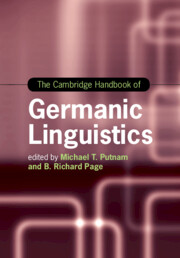Book contents
- The Cambridge Handbook of Germanic Linguistics
- Cambridge Handbooks in Language and Linguistics
- The Cambridge Handbook of Germanic Linguistics
- Copyright page
- Contents
- Figures
- Maps
- Tables
- Contributors
- Acknowledgments
- Germanic Languages
- Part I Phonology
- Part II Morphology and Agreement Systems
- Part III Syntax
- Part IV Semantics and Pragmatics
- Part V Language Contact and Nonstandard Varieties
- Chapter 29 Second Language Acquisition of Germanic Languages
- Chapter 30 Urban Speech Styles of Germanic Languages
- Chapter 31 The West Germanic Dialect Continuum
- Chapter 32 The North Germanic Dialect Continuum
- Chapter 33 Heritage Germanic Languages in North America
- Chapter 34 Minority Germanic Languages
- Chapter 35 Germanic Contact Languages
- Index
- References
Chapter 35 - Germanic Contact Languages
from Part V - Language Contact and Nonstandard Varieties
Published online by Cambridge University Press: 31 March 2020
- The Cambridge Handbook of Germanic Linguistics
- Cambridge Handbooks in Language and Linguistics
- The Cambridge Handbook of Germanic Linguistics
- Copyright page
- Contents
- Figures
- Maps
- Tables
- Contributors
- Acknowledgments
- Germanic Languages
- Part I Phonology
- Part II Morphology and Agreement Systems
- Part III Syntax
- Part IV Semantics and Pragmatics
- Part V Language Contact and Nonstandard Varieties
- Chapter 29 Second Language Acquisition of Germanic Languages
- Chapter 30 Urban Speech Styles of Germanic Languages
- Chapter 31 The West Germanic Dialect Continuum
- Chapter 32 The North Germanic Dialect Continuum
- Chapter 33 Heritage Germanic Languages in North America
- Chapter 34 Minority Germanic Languages
- Chapter 35 Germanic Contact Languages
- Index
- References
Summary
Historically, language contact has taken place under conditions of trade, imported slave and contract labor, military service, conquest, colonialism, migration, and urbanization. The linguistic outcomes are determined in large part by the social relations among populations — including economic, political, and demographic factors — and by the duration of contact. In some times and places, interactions between linguistically heterogeneous groups have generated (depending on one’s theoretical orientation) new languages or radically different language varieties. This article examines the formation of contact languages — understood here primarily as pidgins, creoles, and bilingual mixed languages — the history of which involves a Germanic language in a significant way.
- Type
- Chapter
- Information
- The Cambridge Handbook of Germanic Linguistics , pp. 833 - 864Publisher: Cambridge University PressPrint publication year: 2020



